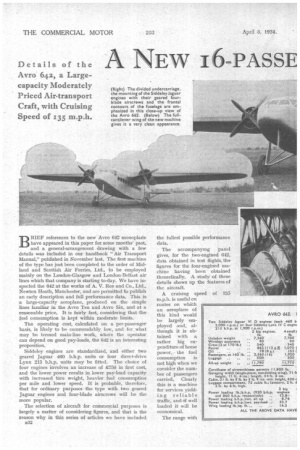A NEW i6-PASSE
Page 50

Page 51

If you've noticed an error in this article please click here to report it so we can fix it.
GER MONOPLANE
Details of the Avro 642, a Large capacity Ms derately Priced Air.transport Craft, with Cruising Speed of 1135 mph.
Tw engined and Four-engined Models suitable for Routes on which Good Pay-loads are
egularly Available
RIEF references to the new Avro 642 monoplane • have appeared in this paper for some months' past,
and a general-arrangement drawing with a few details was included in our handbook "Air Transport Manual," published in November last. The first machine of the type has just been completed to the order of Alidland and Scottish Air Ferries, Ltd., to be employed mainly on the London-Glasgow and London-Belfast air lines which that company is starling to-day. We have inspected the 642 at the works of A. V. Roe and Co., Ltd., Newton Heath, Manchester, and are permitted to publish an early description and full performance data. This is a large-capacity aeroplane, produced on the simple lines familiar in the Avro Ten and Avro Six, and at a reasonable price. It is fairly fast, considering that the kuel consumption is kept within moderate limits.
The operating cost, calculated on a per-passenger basis, is likely to be commendably low, and for what may be termed main-line work, where the operator can depend on good pay-loads, the 642 is an interesting proposition.
Siddeley engines are standardized, and either two geared Jaguar 460 b.h.p. units or four direct-drive Lynx 215 b.h.p. units may be fitted. The choice of four engines involves an increase of £750 in first cost, and the lower power results in lower pay-load capacity with increased tare weight, heavier fuel consumption per mile and lower speed. It is probable, therefore, that for ordinary purposes the type with two geared Jaguar engines and four-blade airscrews will be the more popular.
The selection of aircraft for commercial purposes is largely a matter of considering figures, and that is the reason why in this series of articles we have included B32 the fullest possible performance data.
The accompanying panel gives, for the two-engined 642, data. obtained in test flights, the figures for the four-engined machine having been obtained theoretically. A study of these details shows up the features of the aircraft.
A cruising speed of I 55 m.p.h. is useful on routes on which an aeroplane of this . kind would be largely ernployed and, although it is obtained with a rather big ex. penditure of horse power, the fuel consumption is not high when we consider the number of passengers carried. Clearly this is a machine for services yielding reliable traffic, and if well loaded it will be economical.
The range with full pay-load will not suffice for the London-Scotland run without need for refuelling en route, but the tanks are big enough for a range of 600 miles, so that with 12 passengers and 500 lb. of luggage or freight (which may be looked on as a good average commercial load) the two-engine type will have all the range it needs for operation on the London-Scotland and any other route in these islands.
The wing loading, 16.2 lb. per sq. ft., is rather high and the landing speed is, therefore, somewhat fast by 2.877 comparison with many current British types of commercial aeroplane, but is reasonably low having regard to
400 miles 3.149 hrs.
194 galls. 558 miles. 4.39 hrs. t b e comparatively high cruising and top speeds. The Avro 642 would not
have difficulty in landing on any commercial aerodrome, even in this country where aerodromes are notoriously small. Dunlop pneumatic wheel brakes are fitted. Complete dual control is provided.
The cabin is large and lofty, the height at the front end being no less than 7 ft. 6 ins. The only obstructions in it are the two spars of the all-wood wing and some oblique struts which are not inconvenient. A lavatory and a large baggage hold are provided.
The absence of all engines from the fuselage is conducive to silence and the cabin walls would normally be lagged with sound-deadening material. The cabin windows are of Celastoid and are not made to open unless specially required. Ventilation and interiorheating systems have individual controls.
There is no feature in the construction of the 642 that has not been tried out fully in other models produced by this old-established company. The system employed gives simplicity in manufacture, economy in maintenance, ease of repair and long life—even in extreme climatic conditions.
An unbraced cantilever monoplane wing is used. The spars have laminated spruce flanges and plywood webs ; the ribs have plywood webs and rectangular spruce flanges. The wing has no internal bracing and is covered (except behind the rear spar) with a glued and bradded plywood skin. The portion aft of thereat spar is a fabric-covered structure.
The petrol-tank bays are immediately inboard of the engine mountings, and the feed is by dual enginedriven pumps. The long, narrow ailerons are operated by tie rods and stranded steel cables. The fuselage is of welded tubular steel construction and is built in a unit,. likewise the empennage.




































































































